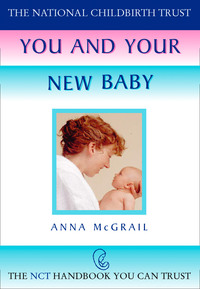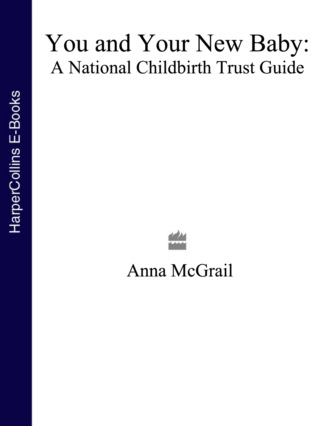
Полная версия
You and Your New Baby
DRESSING YOUR BABY
1. Place your baby on her changing mat or other comfortable surface. Put on your baby’s nappy. Talk to your baby while you dress her, telling her what you ‘re doing, the names of things, perhaps counting the poppers.
2. The vest. Gather up the vest around the neck opening. Stretch this opening wide and place it at the back of the baby’s head.
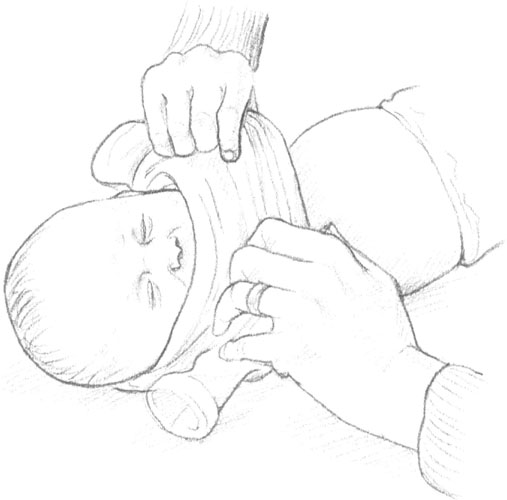
3. Use the fabric of the vest to gently lift your baby’s head and slide the fabric over. Pull the fabric down at the back of the head first, and then, without taking your fingers from the neck opening, lift the vest over your baby’s face. Stay calm if she starts to wriggle and don’t try to rush – you’ll frighten her more.
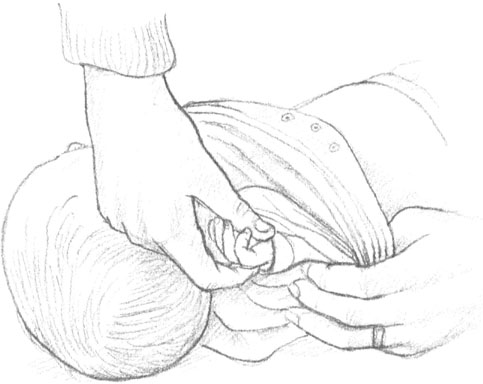
4. Gather up one arm opening. Reach through it, find your baby’s hand, and enclose her tiny fingers in your own. With your other hand, pull the sleeve downwards over your baby’s arm. This way, you won’t bend or hurt her fingers. Settle the sleeve over your baby’s shoulder. Repeat with the other arm.

5. Hold your baby’s ankles in one hand, with a finger between her feet so that her feet aren’t pressed uncomfortably together. Lift her legs up so that her bottom is raised slightly up from the mat and you can pull the vest down underneath it.
6. Pull the vest down in front and fasten the poppers.
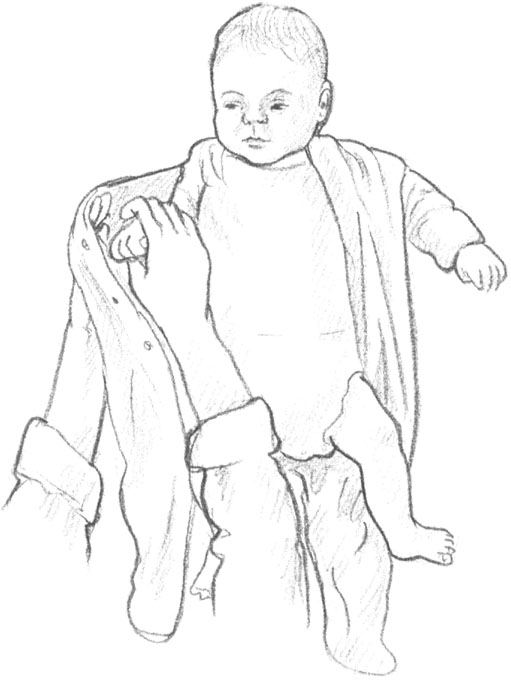
7. The sleepsuit. Put the sleepsuit down flat on the mat, open, with all the poppers undone. Put the baby on top of the sleepsuit.
8. Gather up one sleeve and open the cuff of the sleeve with one thumb and forefinger. Stretch the cuff wide and guide it over your baby’s fist. Hold her hand in yours as you pull the sleeve up her arm. Repeat with the other sleeve.
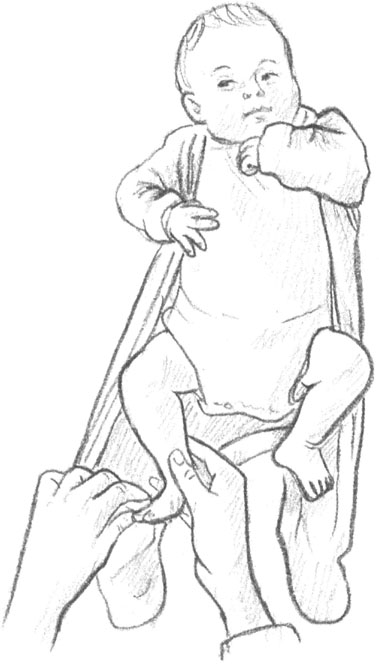
9. Guide the first leg into the sleepsuit’s leg opening and gently pull the fabric up her leg until her toes reach the foot of the suit. Make sure all the toes are comfortably in and not bent. Repeat with other leg.

10. Fasten the poppers – either from the top down or the bottom up. If you start in the middle you can be guaranteed to have an odd popper left over at either end.
11. Smile. You’ve done it!
SLEEP FACTS
Newborn babies do need a lot of sleep, 18 hours a day is not unusual. If your baby seems to be having less than this, it may be because she is having it in short bursts rather than long naps
Sleep is good for babies. Growth hormones reach high levels while they sleep, and your baby needs time to rest and recuperate from the constant new stimulus of the world
Babies need feeding at night. She needs food at frequent intervals, so you have to expect her to ask for it at least until she is three or four months old
Babies’ sleep patterns will change radically during the first six months of life. By the time your baby is six months old, she may well be sleeping between 10 and 12 hours each night (even if this is broken) with two or three hours during the day, often in two distinct naps, morning and afternoon.
SLEEPING
BEFORE YOUR baby was born, he could wake and dream and sleep at will, at whatever hours suited him. There was no one else to take into account. In the first days and weeks after the birth, your baby will try to persist with this individual pattern, sleeping whenever it suits him. This is why the subject of sleep is such a hot issue for new parents, because, as soon becomes obvious, a baby who sleeps whenever it suits him will come into conflict with the pattern adopted by most adults: namely, doing the greater part of their sleeping during the hours of darkness.
While you cannot expect your baby to adopt a pattern of eight hours of sleep every night from Day One, equally you do not have to let your baby dictate when you sleep ad infinitum. Playtime at 3am is bound to cause conflict with wider society eventually.
And sleep deprivation is so profound a problem that it has been used as a method of torture for centuries. If you don’t get enough sleep, the whole family will suffer.
So, although you may have got through the first days or weeks in a fog, sleeping when the baby sleeps, what can you do to establish the pattern and routines that will suit everybody?
How much sleep?
THIS IS A burning question mainly for those parents who feel their child isn’t getting enough sleep. If pressed further, and if they are being honest, those same parents might admit that in fact they are more worried about themselves not getting enough sleep.
Worrying about sleep can make matters worse, as it did for Hazel: ‘I looked at a book and it said he should be sleeping around 18 to 20 hours a day – this was when he was about two weeks old. And he wasn’t sleeping anywhere near that. And I’d read somewhere else that babies only grew when they were asleep so I thought he’d end up being tiny. I was trying to make him go to sleep all the time so he’d grow and this drove me to distraction.’
A sleepy state can be perfectly natural for some babies, as Jennifer tells: ‘I couldn’t even tell whether he was asleep or not. He ended up in this permanent half-doze, especially in those early days when I was so keen for him to suckle and build up my milk supply.’
Encouraging your child to settle
Have a definite ‘winding down’ routine for the evenings: for example: looking at a book, bath, feed, change and donning of ritual ‘nightclothes’ (even if these are indistinguishable from the day clothes as your baby only wears sleepsuits)
Don’t get your baby used to falling asleep only in certain situations (like in the car or the pram or at the breast) as she will come to associate these circumstances with sleep and you will find yourself driving round the block at 3am
Keep the room at a comfortable temperature: 18 degrees C (65 degrees Fahrenheit) is ideal
Let your baby settle herself to sleep if she can; for example: don’t rush to her and pick her up the instant her eyelids flutter open – she may want to gently drift off again
Keep the atmosphere in the house as calm and relaxed as you can, but don’t tiptoe round her and feel you have to stay quiet; the womb is one of the noisiest places on earth – heartbeats, gurglings, joint movements, hearing people talking – and your baby fell asleep there.
YOU MAY FIND that one frequently asked question about your baby is: ‘Is he settled yet?’ This idea of the ‘settled’ baby is quite prevalent, and implies a magical transformation from the unpredictable bundle of the newborn to a well-organised, easily manageable baby with regular feeds and hours when you know she will probably nap. This magical transformation is expected to occur somewhere between six weeks and three months.
Some make this magical transformation a little later; some a lot later (although most parents find that by the time their child starts school things have been more manageable for quite a while). Some ‘settle’ spontaneously. Others will if you guide them in the right direction, providing them with stable and secure patterns that mean your baby can predict from one day to the next what will be happening.
When your baby is born, short spells when she is awake will alternate with sleeps which can be a few hours or only several minutes long. Day or night makes no difference to your baby – sleep patterns are something we are socialised into. You may long for your baby to sleep 12 hours straight through at night, for example, but if you were living in Spain, perhaps, you might prefer her to have a long afternoon sleep during the heat of the day and only eight or nine hours at night. Whatever pattern you choose, that will be the one you will be trying to guide your baby into – and there is nothing wrong with that. Patterns make life easier for everyone. Therefore, if your baby hasn’t ‘settled’ by three months of age or so, you may like to help her find a pattern of sleeping and waking that suits her, and whose hours and predictability suit you.
OWN ROOM/PARENTS’ ROOM
Own room
Advantages
Parents have their own space
The baby starts off in his own room and won’t have the trauma of transfer at a later stage
Конец ознакомительного фрагмента.
Текст предоставлен ООО «ЛитРес».
Прочитайте эту книгу целиком, купив полную легальную версию на ЛитРес.
Безопасно оплатить книгу можно банковской картой Visa, MasterCard, Maestro, со счета мобильного телефона, с платежного терминала, в салоне МТС или Связной, через PayPal, WebMoney, Яндекс.Деньги, QIWI Кошелек, бонусными картами или другим удобным Вам способом.


